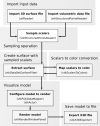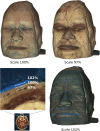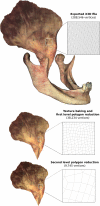True-color 3D rendering of human anatomy using surface-guided color sampling from cadaver cryosection image data: A practical approach
- PMID: 35224742
- PMCID: PMC9296043
- DOI: 10.1111/joa.13647
True-color 3D rendering of human anatomy using surface-guided color sampling from cadaver cryosection image data: A practical approach
Abstract
Three-dimensional computer graphics are increasingly used for scientific visualization and for communicating anatomical knowledge and data. This study presents a practical method to produce true-color 3D surface renditions of anatomical structures. The procedure involves extracting the surface geometry of the structure of interest from a stack of cadaver cryosection images, using the extracted surface as a probe to retrieve color information from cryosection data, and mapping sampled colors back onto the surface model to produce a true-color rendition. Organs and body parts can be rendered separately or in combination to create custom anatomical scenes. By editing the surface probe, structures of interest can be rendered as if they had been previously dissected or prepared for anatomical demonstration. The procedure is highly flexible and nondestructive, offering new opportunities to present and communicate anatomical information and knowledge in a visually realistic manner. The technical procedure is described, including freely available open-source software tools involved in the production process, and examples of color surface renderings of anatomical structures are provided.
Keywords: 3D graphics; anatomy education; medical visualization; surface rendering.
© 2022 The Author. Journal of Anatomy published by John Wiley & Sons Ltd on behalf of Anatomical Society.
Figures








Similar articles
-
Embedding interactive, three-dimensional content in portable document format to deliver gross anatomy information and knowledge.Clin Anat. 2021 Sep;34(6):919-933. doi: 10.1002/ca.23755. Epub 2021 May 21. Clin Anat. 2021. PMID: 33982339
-
New views of male pelvic anatomy: role of computer-generated 3D images.Clin Anat. 2004 Apr;17(3):261-71. doi: 10.1002/ca.10233. Clin Anat. 2004. PMID: 15042576
-
Volumetric visualization of anatomy for treatment planning.Int J Radiat Oncol Biol Phys. 1996 Jan 1;34(1):205-11. doi: 10.1016/0360-3016(95)00272-3. Int J Radiat Oncol Biol Phys. 1996. PMID: 12118552
-
Practical Step-by-step SYNAPSE VINCENT Rendering of Three-dimensional Graphics in Horseshoe Kidney with Bilateral Varicoceles.JMA J. 2024 Oct 15;7(4):471-486. doi: 10.31662/jmaj.2024-0058. Epub 2024 Aug 9. JMA J. 2024. PMID: 39513055 Free PMC article. Review.
-
Building virtual models by postprocessing radiology images: A guide for anatomy faculty.Anat Sci Educ. 2010 Sep-Oct;3(5):261-6. doi: 10.1002/ase.175. Anat Sci Educ. 2010. PMID: 20827725 Review.
References
-
- Ackerman, M.J. (1998) The Visible Human Project: a resource for anatomical visualization. Studies in Health Technology and Informatics, 52, 1030–1032. - PubMed
-
- Ackerman, M.J. , Yoo, T. & Jenkins, D. (2001) From data to knowledge—the Visible Human Project continues. Studies in Health Technology and Informatics, 84, 887–890. - PubMed
-
- Assaf, Y. & Pasternak, O. (2008) Diffusion tensor imaging (DTI)‐based white matter mapping in brain research: a review. Journal of Molecular Neuroscience, 34, 51–61. - PubMed
-
- Azkue, J.J. (2021a) Embedding interactive, three‐dimensional content in portable document format to deliver gross anatomy information and knowledge. Clinical Anatomy, 34, 919–933. - PubMed
MeSH terms
LinkOut - more resources
Full Text Sources
Medical

